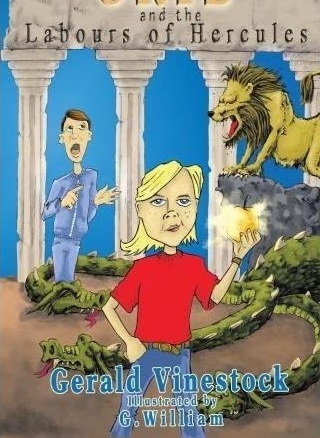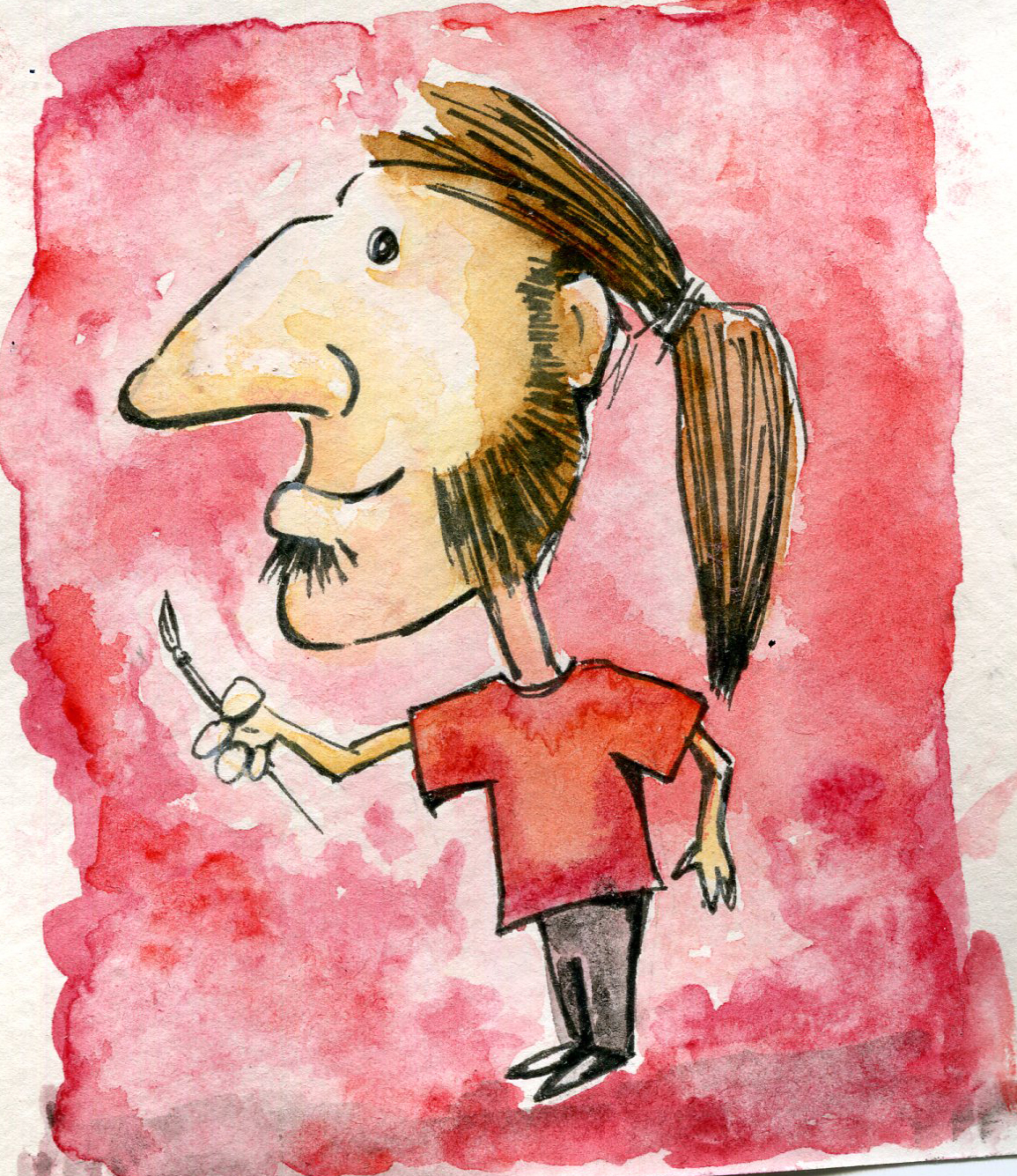Title of the work
Country of the First Edition
Country/countries of popularity
Original Language
First Edition Date
First Edition Details
Gerald Vinestock, Crib and the Labours of Hercules, ill. by G. William. Caterham: Bobaloo Books, 2017, 178 pp.
ISBN
Genre
Fiction
Humor
Illustrated works
Mythological fiction
Target Audience
Children (ages 9–14)
Cover

Courtesy of the Author and Illustrator.
Author of the Entry:
Ayelet Peer, Bar-Ilan University, ayelet.peer@gmail.com
Peer-reviewer of the Entry:
Lisa Maurice, Bar-Ilan University, lisa.maurice@biu.ac.il
Daniel A. Nkemleke, University of Yaoundé 1, nkemlekedan@yahoo.com

Courtesy of the Author.
Gerald Vinestock (Author)
Gerald is an ex-headmaster and an author. Crib is his first novel.
Source:
Official website (accessed: Augist 16, 2019)
Bio prepared by Ayelet Peer, Bar-Ilan University, ayelet.peer@gmail.com
Questionnaire
1. What drew you to writing / working with Classical Antiquity and what challenges did you face in selecting, representing, or adapting particular myths or stories?
I had already written a children’s novel using the central characters and was looking for a way in which to use them again. The improbable idea of a 10-year-old girl performing the Labours of Hercules proved attractive. The challenges came from my wish that the Labours should be performed without violence. I needed to find variety in the performing of the Labours.
2. Why do you think classical / ancient myths, history, and literature continue to resonate with young audiences?
Children are good at accepting the credibility of stories which have a mythical element even though they are inherently improbable. A setting which is clearly in the past – “once upon a time” – helps the credibility.
3. Do you have a background in classical education (Latin or Greek at school or classes at the University?) What sources are you using? Scholarly work? Wikipedia? Are there any books that made an impact on you in this respect?
“O” level Latin at age 15 was the extent of my formal classical education. I read widely. Robert Graves was an early source. I used Wikipedia as well.
4. Did you think about how Classical Antiquity would translate for young readers, esp. in (insert relevant country)?
The Labours were performed in Greece and I felt that was sufficiently “foreign” for a UK reader to be able to make the imaginative leap into accepting the events as “fact”.
5. How concerned were you with “accuracy” or “fidelity” to the original? (another way of saying that might be – that I think writers are often more “faithful” to originals in adapting its spirit rather than being tied down at the level of detail – is this something you thought about?)
The fact that the Labours were performed by a young girl meant that I could not adhere to the accepted account of events. I did ensure that all the Labours were achieved and that the various “monsters” were accurately portrayed, though they were all given voices, which, of course, they di not have in any original version.
6. Are you planning any further forays into classical material?
I have written an account of the retrieval of the Golden Fleece; Crib and the Golden Fleece. Crib does rather better than Jason. I am still seeking a publisher.
Prepared by Ayelet Peer, Bar-Ilan University, ayelet.peer@gmail.com

Courtesy of the Author.
G. William (Illustrator)
William is an artist. He specializes in illustrating children’s books and cartooning.
“Long time doodler and northern boy Guy William is a freelance illustrator who specialises in illustrating children’s books. Working primarily in pen and ink he is know for his excessive cross hatching and inability to stop telling bad jokes, this second “skill” often bleeds into his art and annoys his children and wife.” (by G. William)
Official website (accessed: August 16, 2019)
Bio prepared by Ayelet Peer, Bar-Ilan University, ayelet.peer@gmail.com
Summary
Crib (short for Christabel) is a 10-year-old clever and tomboyish girl, who has gone with her parents to visit relatives in Greece. While she stays with her uncle and aunt and looks after their horses, she hears on the news that strange phenomena are occurring: all the fierce monsters whom the legendary Hercules had vanquished eons ago, have suddenly returned to life and are hurting the local people. The government is desperate for a new Hercules to save the day. Crib’s uncle, Jonathan, a teacher, decides to fly to Greece from England to become the new heroic saviour. Since he is clumsy and clueless, Crib joins him on his quest to follow Hercules’ 12 labours and catch these monsters once more. The story follows the original labours, with slight changes, namely that Atlas is not mentioned, nor the gods since the focus is on the beasts. Most of the beasts are capable of speaking in human tongue and converse with Crib and Jonathan. They are not slaughtered; instead, Crib and Jonathan manage to catch them or persuade them not to hurt people. The only horrific death in the story is that of Diomedes who is pushed to his death by his wife and then eaten by his mares, which, however, later become vegetarians; thus they are not at fault for “their initial bloodlust”. In the end, many of them reside in a specially commissioned “Hercules World” (theme park) and Jonathan and Crib receive the gratitude of the Greek prime minister and the people. The book closes with an epilogue which reveals the fate of all the different ancient characters.
Analysis
This story modernizes the 12 labours in a humorous way. While the encounter between modern-day heroes (usually, juveniles) and the mythical world is rather common in youth literature (for example, in Stella Tarakson’s Hopeless Heroes series or Elena’s Paige Taki & Toula Time Travelers to name a few), in most stories it involves some kind of time-travel or a secret mission to help the gods. In this story, the gods are non-existent and the mythological creatures are recognized by everyone since they terrorize modern Greek cities. Thus the entire quest is overt and everyone accepts the wondrous existence of these creatures, which are part of the ancient tradition. In fact, it seems that the fact that these creatures are part of their tradition is what makes the modern Greeks accept their reemergence, albeit with due bewilderment. The mythological and real-world are therefore intertwined and the mythological beasts demonstrate modern sensitivities. For example, Cerberus wants to raise puppies, and the Erythmanian boar is in love etc. The myth of Hercules’ labours is treated as historical fact, and it is even mentioned that the bones that had been discovered of these mysterious beings have suddenly disappeared.
The focus of this story is on the actual beasts or opponents Hercules faced, and they are given as much attention as Crib’s and Jonathan’s attempts to capture them. These creatures become the heroes of their respective labours. Unlike the original myth, these are not brainless monsters, with each having its own unique personality. The author deliberately chose to give these monsters a voice, an ability to reason and make them able to converse with Crib and Jonathan. The Amazons are also given their own voice (they are not beasts of course, but humans). They are part of a matriarchal society in which they despise Jonathan yet honour Crib. In the end, it is Crib who manipulates the Amazons in order to help her uncle, thus they are not vanquished by a man but by the wits of a girl. While the author emphasizes the role of the female heroine Crib, the Amazon society is a faulty one since they also do not respect the male gender. They did not create an equal society as well.
Thus the monster-slaying repeated motif of the original myth is replaced by a message of mutual understanding and acceptance. Crib and Jonathan use their wits and compassion to try and persuade these beasts to mend their ways; they do not set out to kill them. They give them a chance to reform. This is an important message regarding the definition of monsters, and regarding accepting and understanding others; should we simply fear and eliminate those whom we consider dangerous monsters or should we try and reach out to them? These mythological monsters, whose sole existence was to wreak havoc and die by the hands of the heroic Hercules, have their own stories to tell and to share with the world. They are not malignant creatures and even if they do harm humans, they are willing to change (for example, the Nemean Lion or the Erymanthian Boar). In the epilogue, we learn of their aftermath peaceful co-existence with the humans.
While the story is narrated in a comical and lighthearted tone the messages it illustrates are strong and powerful ones about helping others and not giving up on them, and about trying to find the human in the monster. There is also an ecological message here concerning the preservation of animals (mythological or not) and their integration with nature, or, if this is not possible, then on a special reservation, such as the Hercules park.
Furthermore, the story also reflects on the meaning of heroism. Jonathan wishes to become the new Hercules because he wants to become famous. Crib is more concerned for the welfare of her relatives and their horses. Neither is venturing on this quest from pure altruistic reasons to save the entire Greek nation. It is, of course, true, however, that Hercules himself performed these labours from very personal reasons as well.
The author also ironically introduces the Greek government as a helpless institution, which is first in denial of the crisis, then cries for help and later criticizes the received help by referring to Jonathan’s ineptness. The duo is then followed by a reporter, who documents their adventures in glorifying terms, almost as if he was their own modern Homer or mythographer. Thus the creation of a (modern) myth, with the help of the media is presented. The adventures are as important as the articles about them. Without publicity, can one truly be considered a hero?
The feminist tone of the story is manifested in the character of Crib, who does not like “girly” things very much, but in the end is almost denied her share of the glory because of her gender, when the Greek reporter exclaims that she is a girl and the hero must be a man, like Hercules. Furthermore, the magical Hind, who is female, helps the duo the most, in an aspiration to become famous herself. Yet the Amazons, also female, are not credited with too much intelligence or as well-behaved.
To conclude, this story is unique in the innovative ways it approaches the mythological labours, by accentuating the monsters and not just their human opponents.


